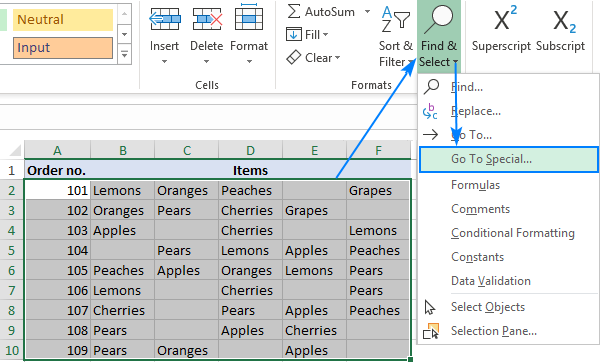Getting My Excel Links Not Working To Work
Wiki Article
Rumored Buzz on Excel Links Not Working
Table of ContentsExcel Links Not Working Fundamentals ExplainedOur Excel Links Not Working StatementsUnknown Facts About Excel Links Not WorkingThe 5-Minute Rule for Excel Links Not WorkingThe 2-Minute Rule for Excel Links Not Working

Range calculation functions like either can not handle whole column references or compute all the cells in the column. User-defined features do not instantly acknowledge the last-used row in the column and, consequently, frequently determine whole column referrals inefficiently. It is easy to program user-defined features so that they acknowledge the last-used row.

Excel Links Not Working Fundamentals Explained
Making use of the formula for a vibrant variety is generally more suitable to the formula since has the downside of being an unstable feature that will be computed at every recalculation. Performance lowers due to the fact that the feature inside the vibrant array formula have to examine lots of rows.$A$ 1) - 1,1) You can also utilize features such as to build dynamic arrays, yet is unstable as well as constantly determines single-threaded.
Making use of several vibrant arrays within a single column requires special-purpose checking functions. Using numerous vibrant ranges can lower performance. In Workplace 365 variation 1809 and later on, Excel's VLOOKUP, HLOOKUP, and also suit for specific suit on unsorted data is much faster than ever prior to when seeking out multiple columns (or rows with HLOOKUP) from the very same table array.
If you use the precise match alternative, the calculation time for the function is proportional to the number of cells checked prior to a match is located. Lookup time making use of the approximate match options of,, as well as on arranged information is fast and also is not dramatically raised by the length of the range you are looking up.
The Ultimate Guide To Excel Links Not Working
Ensure that you recognize the match-type and range-lookup options in,, and. The adhering to code example reveals the syntax for the function. MATCH(lookup value, lookup range, matchtype) returns the largest suit much read here less than or equal to the lookup value when the lookup variety is sorted rising (approximate match).The default alternative is approximate suit arranged ascending. The complying with code instance reveals the phrase structure for the and also functions.
VLOOKUP(lookup value, table selection, col index num, range-lookup) HLOOKUP(lookup worth, table range, row index num, range-lookup) returns the biggest suit much less than or equivalent to the lookup worth (approximate suit). Table range need to be arranged rising.
Some Of Excel Links Not Working
If your information is sorted, but you want an exact match, see Use two lookups for arranged information with missing values. Attempt utilizing the and also functions instead of. Although is slightly much faster (roughly 5 percent much faster), less complex, as well as uses less memory than a mix of and also, or, the additional adaptability that and also deal often enables you to dramatically save time.
The feature is fast and is a non-volatile feature, which speeds up recalculation. The function is additionally quick; nonetheless, it is an unpredictable feature, and it occasionally considerably increases the time taken to process the computation chain.$A$ 2:$F$ 1000, SUIT(A1,$A$ 1:$A$ 1000,0),3) Since exact suit lookups can be sluggish, take into consideration the adhering to choices for improving efficiency: Use one worksheet.
When you can, the data initially (is quick), and utilize approximate match. dig this When you have to utilize a specific match lookup, restrict the array of cells to be scanned to a minimum. Usage tables and also structured references or vibrant range names as opposed to describing a a great deal of rows or columns.
Excel Links Not Working - The Facts
2 approximate suits are considerably faster than one specific match for a lookup over more than a few rows. (The breakeven factor is regarding 10-20 rows.) If you can arrange your data but still can not make use of approximate match since you check that can not make sure that the value you are seeking out exists in the lookup variety, you can utilize this formula: IF(VLOOKUP(lookup_val, lookup_array,1, True)=lookup_val, _ VLOOKUP(lookup_val, lookup_array, column, True), "notexist") The initial part of the formula works by doing an approximate lookup on the lookup column itself.VLOOKUP(lookup_val, lookup_array, column, Real) If the solution from the lookup column did not match the lookup value, you have an absent value, as well as the formula returns "notexist". Realize that if you search for a value smaller sized than the tiniest worth in the list, you get an error. You can handle this mistake by utilizing, or by including a small test worth to the listing.
Beginning with Excel 2007, you can make use of the feature, which is both simple and fast. IF IFERROR(VLOOKUP(lookupval, table, 2 FALSE),0) In earlier versions, a straightforward however sluggish means is to utilize a feature which contains two lookups. IF(ISNA(VLOOKUP(lookupval, table,2, FALSE)),0, _ VLOOKUP(lookupval, table,2, FALSE)) You can prevent the double specific lookup if you utilize exact as soon as, keep the result in a cell, and then examine the outcome prior to doing an.
Report this wiki page